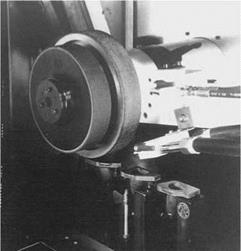6.5.1 Application of Vitrified Bonds
Vitrified bond alumina wheels represent nearly half of all conventional wheels and are employed for the great majority of precision high-production grinding applications. Vitrified superabrasive technology, especially for CBN, is the fastest growing sector of the precision grinding market but is still less than 20% of the market total.
6.5.2 Fabrication of Vitrified Bonds
 |
Vitrified bonds are essentially glasses made from high-temperature sintering of powdered glass frits, clays, and chemical fluxes such as feldspar and borax. The attractions of vitrified bonds are their high-temperature stability, brittleness, rigidity, and their ability to support high levels of porosity in the wheel structure. The mixture of frits, clays, and fluxes are blended with abrasive and a binder such as dextrin and water. The mixture is pressed in a mold usually at room temperatures. The binder imparts sufficient green strength for the molded body to be mechanically handled
on the abrasive and glass formulation. The frit provides the actual glass for vitrification, the clays are incorporated to provide green strength up to the sintering temperature, while the fluxes control/modify the surface tension at the abrasive grain-bond interface. Clays and flux additions, therefore, control the amount of shrinkage, which, except for the very hardest of wheel grades, is kept to a minimum. It should also be noted that the pressing stage in wheel manufacture, which is done either to a fixed pressure or fixed volume, provides a controlled volume of porosity after firing.
Some typical conventional vitrified wheel specifications are given in Table 6.4 that comply with standard coding practice.
6.5.3 Structure and Grade of Conventional Vitrified Wheels
In addition to the grit type and size discussed above, it can be seen that two other factors are key to the wheel specification: Grade or hardness designated by a letter, and Structure, which is designated by a number.
